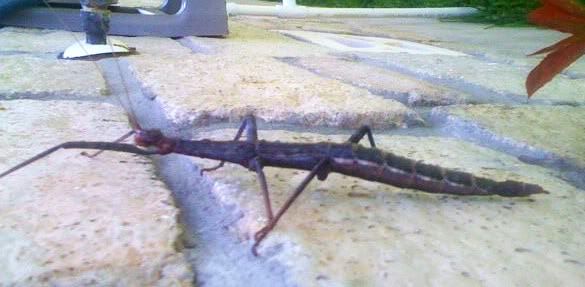
I have come to accept over the 3 1/2 years that we've lived in Texas that everything is bigger here. Last weekend, I came practically face-to-face with an example of that belief--a Megaphasma dentricus was hanging out by our garden hose reel.
Silly me was reaching over to unwind the hose when I noticed something not quite right on the wall in front of me. A six-inch bug was hanging out, just enjoying the shade in the summer heat. After a squeal or two, I hollered for Jerry to come over to take a photo of the unbelievably big bug with his IPhone. I have seen walking stick bugs before, but nothing like this baby.
It was HUGE. Okay, not Godzilla-type huge, but big enough to freak me out. I am not afraid of bugs; I just don't appreciate them the way they probably want to be appreciated. I know they don't bite. They aren't poisonous and probably don’t want to deal with me as much as I don't want to deal with him. Or her. I wasn't quite sure how to tell the sex of a Megaphasma dentricus or otherwise known as a Walking Stick.
This particular bug is a Texas version that gets up to seven inches long. Ours was pretty darn close. I wasn't going to get a tape measure to find out for sure. I respectfully left it alone to continue on its journey.
I've mentioned before about the bugs here--the freaky big centipedes here are disgusting. Sorry, but those really freak me out. The ones we saw were Texas Redheaded Centipedes. I kid you not.
Texas redheaded centipedes, or Scolopendra heros castaneiceps, are a subspecies of Scolopendra heros. They are one of the world's largest centipede species and can grow to be as long as 12 inches. Their heads are red, with segmented dark blue, purple or black bodies. Each segment bears a pair of yellow legs.
The Texas redheaded centipede can be found throughout much of the Southwestern United States, as well as in Northern Mexico. Texas redheaded centipedes prefer dark, moist environments and will take cover during the day. Rock crevices, leaf litter and rocks provide shelter, although the Texas redheaded centipede can also burrow into the ground. After dark, Texas redheaded centipedes hunt for prey; insects are their chief food source.
The tails of these centipedes resemble their heads. This characteristic serves to confuse predators. In addition, they are equipped with a painful, venomous bite, which can incapacitate and kill small prey and predators.
While the Texas redheaded centipede's bite will not kill humans, it may be extremely painful for up to two days. Individuals with known insect allergies may experience more severe reactions and should contact a medical professional.
http://www.orkin.com/other/centipedes/texas-redheaded-centipede

My son Jared said he saw a huge centipede when he was working at a Home Depot here in San Antonio. He said he heard it before he saw it. If it made him nervous, I can't imagine what I'd do.
I have a healthy respect. And a weekend doesn't go by when I see a critter I've never seen before. Creeping, crawling, slithering and scuttling around my yard--it's rarely dull.
I always wear shoes when outside. I learned my lesson the past Halloween when I stepped on a scorpion out on the driveway. Not an episode I'd like to repeat anytime soon.
Texas is only for the brave--bug wussies need not apply.
These red head pedes are marked same colors of a coral snake- red, yellow & black. When I was a boy we used to catch them and when they are discovered they come out from cover running full tilt with fangs open, head up off ground several inches and wriggling as fast as they can go. And their bite is EXTREMELY painful for a long time. We used to drop 4-5 grasshoppers in their quarters- a large one can easily hold 3 down while it devours a fourth. The last two specialized legs at the end of the body are extremely powerful and have no trouble holding prey.
ReplyDelete